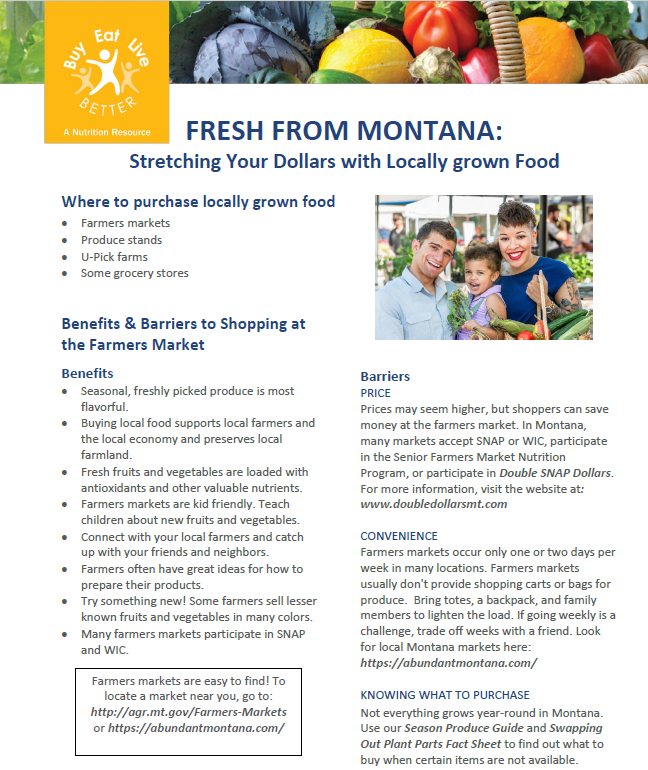Stretching Your Food Dollars With Locally Grown Food

Where to purchase locally grown food
- Farmers markets
- Produce stands
- U-Pick farms
- Some grocery stores
Benefits & Barriers to Shopping at the Farmers Market
Benefits
- Seasonal, freshly picked produce is most flavorful.
- Buying local food supports local farmers and the local economy and preserves local farmland.
- Fresh fruits and vegetables are loaded with antioxidants and other valuable nutrients.
- Farmers markets are kid friendly. Teach children about new fruits and vegetables.
- Connect with your local farmers and catch up with your friends and neighbors.
- Farmers often have great ideas for how to prepare their products.
- Try something new! Some farmers sell lesser known fruits and vegetables in many colors.
- Many farmers markets participate in SNAP and WIC.
Barriers
Prices may seem higher, but shoppers can save money at the farmers market. In Montana, many markets accept SNAP or WIC, participate in the Senior Farmers Market Nutrition Program, or participate in Double SNAP Dollars. For more information, visit the website at: www.doubledollarsmt.com
Farmers markets occur only one or two days per week in many locations. Farmers markets usually don't provide shopping carts or bags for produce. Bring totes, a backpack, and family members to lighten the load. If going weekly is a challenge, trade off weeks with a friend. Look for local Montana markets at https://abundantmontana.com/
Not everything grows year-round in Montana. Use our Season Produce Guide and Swapping Out Plant Parts Fact Sheet to find out what to buy when certain items are not available.
Seasonal Produce in Montana
The Seasonal Produce Chart shows many of the food items grown or raised in this state that are available throughout the four seasons. The chart indicates when fresh items may be available and does not reflect fruits or vegetables that are available after the harvest season due to canning, freezing, or dehydrating.
|
Produce
|
WINTER (DEC-APR)
|
SPRING (MAY-JUNE)
|
SUMMER (JUL-AUG)
|
FALL (SEPT-NOV)
|
|---|---|---|---|---|
|
Apples
|
|
|
|
X
|
|
Apricots
|
|
|
X
|
|
|
Beets
|
X
|
|
X
|
X
|
|
Broccoli/Cauliflower
|
|
X
|
|
X
|
|
Carrots
|
X
|
|
X
|
X
|
|
Cabbage
|
|
X
|
X
|
X
|
|
Cantaloupe
|
|
|
X
|
X
|
|
Chard
|
|
X
|
X
|
X
|
|
Cherries/Raspberries/Strawberries
|
|
|
X
|
X
|
|
Corn
|
|
|
X
|
X
|
|
Cucumbers
|
|
|
X
|
|
|
Garlic
|
|
|
X
|
X
|
|
Green Beans
|
|
|
X
|
X
|
|
Herbs
|
|
X
|
X
|
X
|
|
Kale
|
|
X
|
X
|
X
|
|
Leeks
|
|
|
|
X
|
|
Lettuce/Spanish
|
|
X
|
X
|
X
|
|
Onions
|
X
|
|
|
X
|
|
Parsnips
|
X
|
X
|
|
|
|
Peas
|
|
X
|
X
|
X
|
|
Pears
|
|
|
|
X
|
|
Peppers
|
|
|
X
|
X
|
|
Potatoes
|
X
|
|
|
X
|
|
Summer Squash
|
|
|
X
|
X
|
|
Tomatoes/Tomatillos
|
|
|
X
|
X
|
|
Winter Squash
|
X
|
|
|
X
|


 You may require
You may require